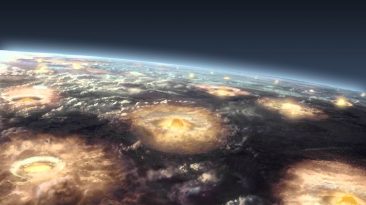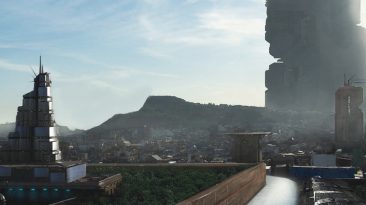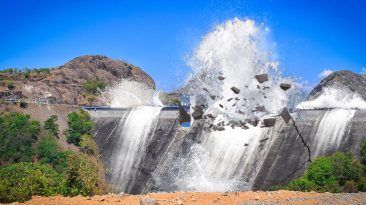What if you could time-travel a hundred years from now. How would the planet look like? Would human beings still be in the picture? Only in the past year, our civilization had to face several dreadful events. Earthquakes, floods, hurricanes, bushfires, and of course, the COVID pandemic have been shaking us to the core.
And, although there is some disagreement among scientists about the short-term possibility of a collapse of civilization, it’s clear that we are facing unprecedented issues. But if it’s true that we are racing to human ruin,
What would be the cause of our collapse? How would it unfold? How long could it take?
In January 2021, a paper published in Frontiers in Conservative Science states that we are on a sixth major extinction path. According to its authors, biodiversity loss, climate disruption, human consumption, and population growth will soon bring us to the end of civilization as we know it.
And this process seems to be irreversible. Even if we ceased emissions tomorrow, it wouldn’t matter. We are already in the climate emergency. So, what should we expect next? But first, let’s take a picture of our current situation.
TODAY – GLOBAL TEMPERATURE + 1°C
We are dealing with a pandemic that has been killing thousands of us worldwide, and because of our ecologically unsustainable lifeways, scientists predict more and more deadly pandemics to come. The planet’s surface temperature increased by 1C (1.8°F), and the top 100 meters (about 328 feet) of the ocean have risen by 0.33°C (0.6°F), killing about 30% of the coral reef globally and activating a chain reaction that is endangering the biodiversity of marine life.
The ices sheets have been decreasing in mass, raising the global sea level by 20 cm (8 inches). Floods are becoming more frequent, threatening coastal life around the world. The population sizes of mammals, birds, amphibians, reptiles, and fishes have decreased by almost 70%.
Pollution and consumerism are depleting the soil, water, and air quality, endangering human health and impacting our food supply. The world’s richest 1 percent now owns half the wealth, and this extreme inequality is slowing down the implementation of drastic measures to avoid the fall of our species.
TEN YEARS FROM NOW – GLOBAL TEMPERATURE + 1.5°C
The global temperature would rise to 1.5°C leaving approximately 70% to 90% of coral reefs to die. And, with it, 25% of marine life. The increased heat could potentially trigger the loss of millions of tonnes of maize, wheat, and soybean. People who rely on fishing and agriculture for their food supply could face famine and would have to move somewhere else to survive. Mass migration would begin.
THIRTY YEARS FROM NOW – GLOBAL TEMPERATURE + 2°C
The Earth’s population would hit 10 billion. The coral reefs and their biodiversity would be close to being wiped out, and marine life and thousands of other species on Earth would begin to extinct.
EIGHTY YEARS FROM NOW – GLOBAL TEMPERATURE + 7°C
Sea levels would rise, forcing hundreds of millions of people to leave their homes and move to the hinterland. The mass migrations would cause conflicts between countries and possibly trigger wars.
The exacerbated lack of food and clean water could decimate the human population. And, these catastrophic events affecting the world’s poorest areas would eventually reach everywhere, generating civil wars and overall chaos. But, at this point, how would Earth look like?
Human beings would leave behind miles of an abandoned civilization and mountains of waste, mostly plastic that wouldn’t disappear for thousands of years. Cities would change drastically due to the sudden lack of human maintenance.
Without workers making sure that pumps divert rainfall and rising groundwater is handled, the subways of huge sprawling cities like New York could flood within hours. And the energy sector would potentially result in disaster. Glitches in nuclear plants could trigger nuclear explosions and leaks, contaminating the surrounding.
Farmland would quickly be taken over by insects, mainly since pesticides would no longer be used. As the years go by, buildings would collapse from erosion and fire. Glass would probably go first, followed by metal structures that would rust and crumble, while stone buildings would weather but last millennia.
It would take millions of years for the planet to recover. But, eventually, it would become lusher and more diverse. Of course, this prediction is absolutely rough, and it could also not happen at all but look around. Does it sound so far off? We need to take drastic measures against climate change or we could be stuck at home for good for heat, pollution, future wars, and new pandemics. Can you imagine what would happen if COVID-19 never disappears?
Sources
- “Climate Emergency Persists As 2020 Ties For Earth’s Hottest Year On Record”. Andrea, Germanos. Common Dreams.
- “The Collapse Of Civilization May Have Already Begun”. Nafeez, Ahmed. 2021. vice.com.
- “End of days: Is Western civilisation on the brink of collapse?”. Spinney, Laura. 2021. New Scientist.
- “Scientists Warn Humanity in Denial of Looming ‘Collapse of Civilization as We Know It'” ecowatch.com
- “‘Terrifying’ New Climate Models Warn Of 6-7°C Of Warming By 2100 If Emissions Not Slashed”. Common Dreams.



























